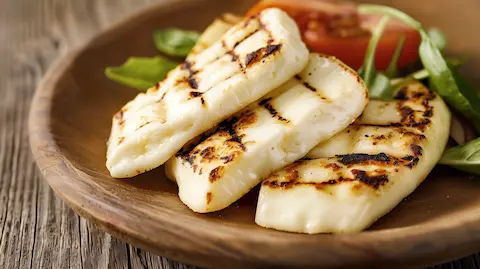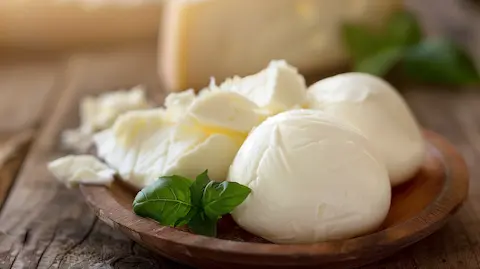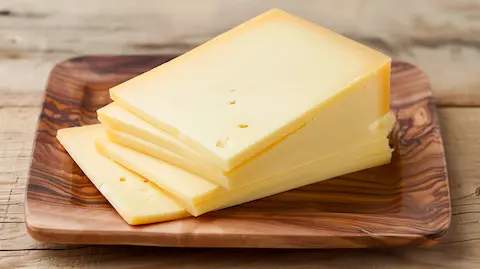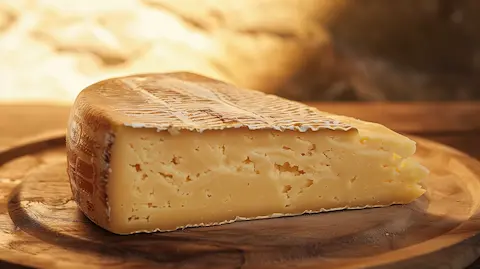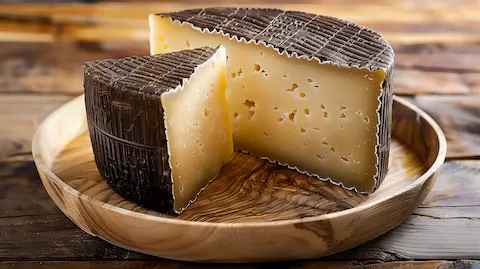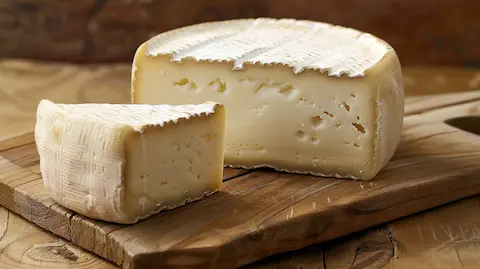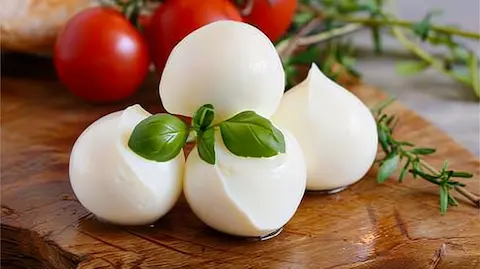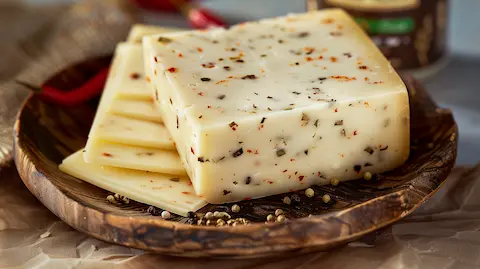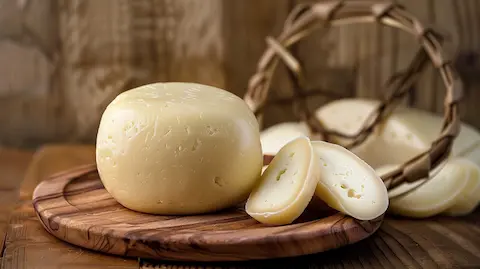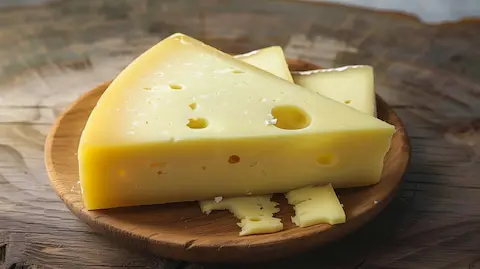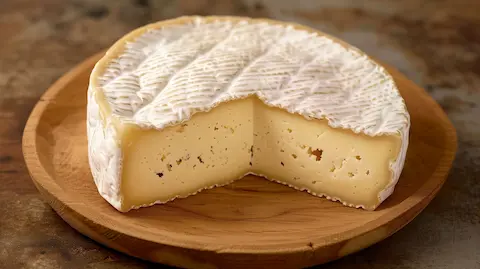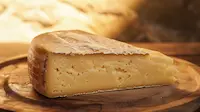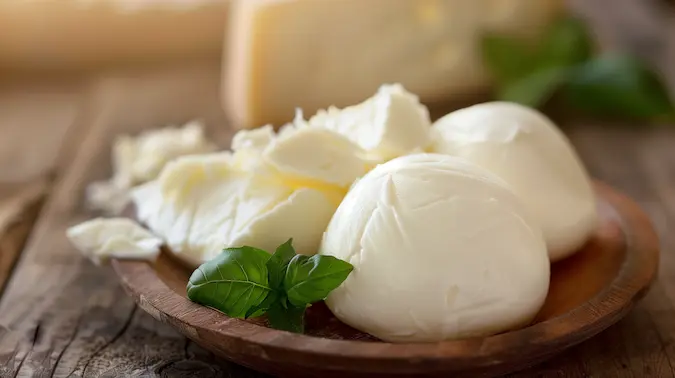Mozzarella Cheese
Mozzarella, a cheese originating from Italy, is celebrated for its delicate, milky taste and distinctive, slightly elastic texture. Traditionally crafted from the milk of water buffaloes, this cheese has found a universal place in kitchens due to its superb melting qualities. Mozzarella's journey from local Italian markets to global fame mirrors the evolution of culinary trends, as it adapts to new cultures and tastes while maintaining its authentic charm.
Today, mozzarella is commonly made from cow's milk, offering a more accessible version without compromising on the creamy, fresh flavor that makes it a favorite topping for pizzas and a key ingredient in various dishes. Its moisture-rich character makes it a versatile cheese, capable of enhancing a dish's texture and flavor profile, whether served fresh or cooked.
How is Mozzarella Made?
Mozzarella cheese is made through a delicate process that begins with the highest quality milk. The milk is first acidified by adding citric acid, which helps the milk to curdle. Rennet, an enzyme crucial for coagulation, is then mixed into the milk to further solidify the curds. Once the milk has reached a thick, yogurt-like consistency, the curds are cut and carefully heated to a specific temperature. This precise heating and stirring process allows the curds to reach the perfect texture for stretching. After being drained of whey, the curds are then stretched and kneaded in hot water, which gives mozzarella its signature elasticity and softness. The final step is forming the cheese into balls and immersing them in cool water to retain their shape. This traditional method ensures that mozzarella retains its characteristic mild flavor and moist, tender consistency.
Explore the intricacies of mozzarella production with our comprehensive table:
Mozzarella Cheese Production Process
| Step | Ingredient | Temperature | Duration | Method |
|---|---|---|---|---|
| Acidification of Milk | Milk, Citric Acid | 32ºC / 90ºF | Citric acid dissolved in water is added to milk and heated. | |
| Addition of Rennet | Rennet | 5 minutes | Rennet dissolved in water is mixed into the warm milk and left to set. | |
| Cutting the Curd | Curds are cut to release whey and heated to 41ºC / 106ºF. | |||
| Heating and Stirring | 41ºC / 106ºF | 5 minutes | Curds are stirred off the heat to encourage whey expulsion and curd firming. | |
| Draining the Curd | Curds are drained in a cheesecloth-lined colander, whey is saved for stretching. | |||
| Stretching the Curd | 76ºC / 150ºF | Curds are stretched in hot water or whey to develop elasticity. | ||
| Forming the Cheese | Cool water bath | Stretched curds are formed into balls and immersed in cool water to set shape. |
What does Mozzarella taste like?
Mozzarella tastes like a gentle whisper of dairy, a subtle hint of creaminess that melds harmoniously with a tender, moist texture. Its flavor is fresh and milky, with a light tanginess that can vary depending on the degree of fermentation. The cheese's delicate nature makes it a versatile companion to bolder flavors, allowing it to meld seamlessly into a variety of culinary creations without overpowering them. Mozzarella's slight elasticity and soft consistency contribute to its unique sensory profile, making it a cherished ingredient in both hot and cold dishes.
Origin: Where does Mozzarella cheese come from?
Mozzarella cheese comes from Italy, with its roots tracing back to the regions of Campania and Lazio. It was initially made from the milk of water buffaloes, which were brought to Italy from India by way of the Mediterranean routes in the early medieval period. The cheese quickly became a staple in the Italian diet and was traditionally produced in the countryside near Naples. Over time, mozzarella's popularity spread, and it became a beloved ingredient in Italian cuisine, eventually gaining international acclaim.
How to Store Mozzarella?
Storing mozzarella correctly is key to maintaining its freshness and flavor. Keep mozzarella in its original packaging if unopened. Once opened, wrap the cheese in cling film or place it in an airtight container with a small amount of water to maintain humidity. Store in the coldest part of the refrigerator, typically at the back, to ensure a consistent temperature.
- Initial Storage: If unopened, keep in original packaging in the refrigerator.
- After Opening: Wrap tightly in cling film or place in an airtight container with water.
- Refrigeration: Store at the back of the fridge to keep temperature consistent.
- Water Bath: For fresh mozzarella, change water every day to keep it moist and fresh.
How long does Mozzarella cheese last?
Mozzarella's shelf life varies by type. Fresh mozzarella should be consumed within a few days, while low-moisture mozzarella has a longer life span. Freezing mozzarella is possible, but expect a change in texture upon thawing; it becomes crumbly, which is fine for cooking. The taste remains largely unaffected, but the cheese is best used melted in dishes post-freezing.
| Type | Outside | Fridge | Freezer | Texture After Thawing | Taste After Thawing |
|---|---|---|---|---|---|
| Fresh Mozzarella | 2 hours | Up to 5 days | Up to 2 months | Crumbly | Unchanged |
| Low-Moisture Mozzarella | 2 hours | 2-3 weeks | 6 months | Crumbly | Unchanged |
Is Mozzarella cheese pasteurized?
Most commercially available mozzarella is made from pasteurized milk, which ensures safety and extends shelf life. However, some artisanal producers may offer mozzarella made from raw milk, adhering to strict guidelines to maintain quality and safety.
Can you freeze Mozzarella?
Yes, you can freeze mozzarella. Freezing extends the cheese's shelf life, making it a practical option for storage. However, it's important to note that freezing may alter the texture, resulting in a crumblier consistency which is still suitable for cooking, especially where the cheese will be melted.
How do you know if Mozzarella cheese has gone bad?
Mozzarella that has spoiled will exhibit signs such as sour smell, mold growth, or a slimy texture. If you consume moldy mozzarella, you risk foodborne illness, which can lead to symptoms like stomach upset, nausea, and vomiting. To ensure safety, discard any mozzarella that shows these signs of spoilage.
Mozzarella Cheese Profile
With its origins steeped in Italian tradition, mozzarella cheese is a testament to the art of cheesemaking. This cheese's profile is as rich as its history, offering enthusiasts a glimpse into its heritage and characteristics.
- Made from: Traditionally water buffalo milk, commonly cow's milk
- Country of origin: Italy
- Region: Campania and Lazio
- Family: Pasta filata
- Type: Fresh
- Texture: Semi-soft, moist, and slightly elastic
- Rind: Rindless
- Colour: White
- Flavour: Mild, milky
- Aroma: Fresh, with a light tanginess
- Vegetarian: Yes, if made with vegetable rennet
- Producers: Numerous, from artisanal cheesemakers to large-scale dairy factories
- Safe for dogs: In small quantities and as an occasional treat
- PDO status: Mozzarella di Bufala Campana has Protected Designation of Origin (PDO) status
Alternatives to Mozzarella Cheese
While mozzarella is a beloved cheese for many, there are occasions when an alternative is sought, whether due to dietary restrictions, flavor preferences, or simply for variety. The following table presents a selection of cheeses that can be used as substitutes for mozzarella, along with their distinct qualities and best uses.
Mozzarella Cheese Substitutes
| Cheese | Milk Source | Texture | Flavor | Melting Quality | Best Used In |
|---|---|---|---|---|---|
| Provolone | Cow | Semi-soft to firm | Mild to sharp, depending on aging | Excellent | Sandwiches, pizzas, baked dishes |
| Ricotta | Cow, sheep, or goat | Soft, creamy | Sweet, milky | Does not melt but becomes creamy | Lasagna, stuffed shells, desserts |
| Gouda | Cow | Semi-soft to hard | Rich, caramel-like, buttery | Good | Cheese boards, sandwiches, sauces |
| Monterey Jack | Cow | Semi-soft | Mild, slightly sweet | Excellent | Nachos, quesadillas, burgers |
| Swiss | Cow | Firm | Nutty, sweet | Good | Fondue, sandwiches, gratins |
| Feta | Sheep, or a blend with goat | Crumbly | Tangy, salty | Softens but doesn't melt smoothly | Salads, pastries, garnishes |
Mozzarella Popular Comparison
Provolone is often set side by side with mozzarella due to their shared origins and similar applications in cooking. Both cheeses belong to the pasta filata family, known for their stretchability when melted. However, provolone offers a sharper taste and firmer texture, which can add a more pronounced flavor to dishes where mozzarella might be too mild.
Mozzarella vs. Provolone Comparison
| Cheese | Origin | Milk Source | Texture | Flavor | Aging Time | Uses |
|---|---|---|---|---|---|---|
| Mozzarella | Italy | Water buffalo or cow | Semi-soft, moist | Mild, milky | None to a few weeks | Pizzas, salads, sandwiches |
| Provolone | Italy | Cow | Semi-soft to firm | Mild to sharp | 2 months to 2+ years | Sandwiches, pizzas, baking |
How to Use Mozzarella
Mozzarella shines in its versatility in the culinary world. Whether melted atop a pizza, tucked into a caprese salad, or baked into a comforting lasagna, its mild flavor and superb meltability make it a go-to cheese for both chefs and home cooks. When cutting mozzarella for cooking, a sharp knife or cheese slicer will yield clean slices without crushing the delicate texture. For shredding, chill the mozzarella in the refrigerator to firm it up, making it easier to grate.
Popular Ways to Enjoy Mozzarella
| Method | Description |
|---|---|
| Sliced | Perfect for sandwiches, caprese salads, or served with tomatoes and basil. |
| Shredded | Ideal for pizza, pasta bakes, and anywhere you desire a gooey, melted cheese. |
| Melted | Use in quesadillas, grilled cheese, or over steamed vegetables for a creamy addition. |
| Diced | Adds a soft, chewy texture to salads, bruschetta, or as a topping for soups. |
| Whole | Enjoy fresh mozzarella balls as a snack or in antipasti platters. |
How to Serve Mozzarella Cheese
Serving mozzarella at its best involves a few key considerations. For fresh mozzarella, bring it to room temperature before serving to enhance its natural flavors and texture. Pair it with complementary ingredients like ripe tomatoes, fresh basil, and a drizzle of olive oil for a classic caprese salad. Alternatively, incorporate mozzarella into hot dishes just before serving to enjoy its delightful melt and stretch.
Recipes Using Mozzarella
Mozzarella cheese is a key player in a multitude of recipes, celebrated for its ability to melt beautifully and complement a wide range of flavors. Its mild taste and stringy texture when melted make it an ideal choice for dishes that require a cheese that can bind ingredients together without dominating the dish's flavor profile.
- Pizza: Mozzarella is the quintessential pizza topping, melting into a stretchy layer that harmonizes with tomato sauce and various toppings.
- Caprese Salad: Fresh mozzarella, paired with ripe tomatoes, basil, and olive oil, showcases the cheese's fresh and milky qualities.
- Lasagna: Its excellent melting property makes mozzarella a staple in this classic Italian dish, providing a gooey layer between the pasta sheets.
- Stuffed Shells: Mozzarella fills pasta shells with a creamy texture, often mixed with ricotta for a rich and satisfying filling.
- Grilled Cheese Sandwich: Mozzarella melts into a deliciously stringy filling, perfect for a comforting grilled sandwich.
- Bruschetta: Topped with diced mozzarella, it melts slightly under the broiler, adding a soft, chewy texture to the toasted bread and fresh tomatoes.
Can You Freeze Mozzarella?
Yes, you can freeze mozzarella. Freezing extends the cheese's shelf life, making it a practical option for storage. However, it's important to note that freezing may alter the texture, resulting in a crumblier consistency which is still suitable for cooking, especially where the cheese will be melted.
Mozzarella Nutrition Data
Mozzarella cheese is a nutritious addition to any diet, offering a good balance of protein and fat, with a moderate amount of calories. There are 280 calories in Mozzarella cheese per 100g. It also provides essential nutrients like calcium and phosphorus, making it a wholesome choice for those looking to enrich their meals.
| Nutrient | Amount per 100g | % Daily Value* |
|---|---|---|
| Calories | 280 | 14% |
| Total Fat | 17g | 26% |
| Saturated Fat | 10g | 50% |
| Cholesterol | 89mg | 30% |
| Sodium | 16mg | 1% |
| Total Carbohydrate | 3.1g | 1% |
| Dietary Fiber | 0g | 0% |
| Sugars | 1g | |
| Protein | 28g | 56% |
| Calcium | 505mg | 51% |
| Iron | 0.2mg | 1% |
*Percent Daily Values are based on a 2000 calorie diet. Your daily values may be higher or lower depending on your calorie needs.
Alternatives to Mozzarella Cheese
While mozzarella is a beloved cheese for many, there are occasions when an alternative is sought, whether due to dietary restrictions, flavor preferences, or simply for variety. The following table presents a selection of cheeses that can be used as substitutes for mozzarella, along with their distinct qualities and best uses.
Mozzarella Cheese Substitutes
| Cheese | Milk Source | Texture | Flavor | Melting Quality | Best Used In |
|---|---|---|---|---|---|
| Provolone | Cow | Semi-soft to firm | Mild to sharp, depending on aging | Excellent | Sandwiches, pizzas, baked dishes |
| Ricotta | Cow, sheep, or goat | Soft, creamy | Sweet, milky | Does not melt but becomes creamy | Lasagna, stuffed shells, desserts |
| Gouda | Cow | Semi-soft to hard | Rich, caramel-like, buttery | Good | Cheese boards, sandwiches, sauces |
| Monterey Jack | Cow | Semi-soft | Mild, slightly sweet | Excellent | Nachos, quesadillas, burgers |
| Swiss | Cow | Firm | Nutty, sweet | Good | Fondue, sandwiches, gratins |
| Feta | Sheep, or a blend with goat | Crumbly | Tangy, salty | Softens but doesn't melt smoothly | Salads, pastries, garnishes |
What's next? WhatCheese insights
If you are seeking to enhance your mozzarella experience, consider the world of artisanal cheesemongers. These specialists offer handcrafted mozzarella that showcases the height of texture and flavor. For those interested in the perfect wine to accompany this cheese, renowned vineyards often host tastings where mozzarella can be enjoyed alongside a curated selection of wines. This pairing elevates the simple pleasure of mozzarella to a gastronomic event.
If you are planning a culinary adventure, keep an eye out for local and regional cheese festivals. These events often feature mozzarella in innovative ways, allowing you to explore its versatility across different cuisines and preparations. Additionally, cooking classes focused on Italian cuisine can provide hands-on experience with mozzarella, from crafting the perfect pizza to mastering the art of a caprese salad.
If you appreciate the semi-soft, moist texture of mozzarella, you might also enjoy exploring other cheeses in this category. Havarti, with its creamy and buttery notes, offers a delightful alternative. Similarly, fontina, known for its nutty flavor and smooth melt, can be a worthy substitute in many dishes where mozzarella is traditionally used. These cheeses, like mozzarella, are excellent for melting and can bring a new dimension to your favorite recipes.

